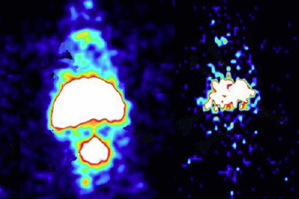It’s drug targeting week (in my world anyway)

 Today I met a pretty awesome person (who looks uncannily like my uncle). Professor of pharmaceutical sciences Ban-An Khaw is an immunology guy, or at least that’s how he classified himself when I asked for his background story. And what an interesting story it is!
Today I met a pretty awesome person (who looks uncannily like my uncle). Professor of pharmaceutical sciences Ban-An Khaw is an immunology guy, or at least that’s how he classified himself when I asked for his background story. And what an interesting story it is!
A few decades ago, Khaw figured out a way to diagnose various forms of heart cell damage — the damage could be from heart attack, a cardiac autoimmune defect, a heart transplant rejection, it didn’t matter. If the cells were damaged, Khaw could find them.
When a heart cell gets hurt, the outer membrane ruptures, exposing the contractile units of the cells just beneath it. Khaw figured that if he tagged imaging molecules (which glow at damaged sites) to antibodies that seek out those contractile mechinary in the muscle cells, then he could find places where they were exposed and by extension, places where the heart tissue has been damaged.
He got pretty far with this work progressing to the point of drug development and FDA approval, but due to various unrelated circumstances, the company he was working with put the project on hold. In the meantime, cardiology moved in a different direction, he said.
And so did Khaw. He realized that his tagging approach could be useful in other ways, in particular for a more efficient, less invasive cancer diagnosis.
The current technology allows doctors to see tumors when they have mass of greater than 1 or 2 grams. “But you want to be able to see milligram amounts,” said Khaw. “You want to see it before it’s large enough so it can send out metastatic lesions.” And this is exactly what he accomplished.
One of Khaw’s method can detect a single cancerous cell in just a few milliliters of blood.
Next he thought that instead of tagging imaging molecules, he could actually tag drug molecules, such that drugs could be delivered directly to a cancerous cell, bypassing the healthy ones and thus avoiding many of the toxic effects that chemotherapy is typically associated with.
This is similar to the work I told you about yesterday, but instead of carrying the drug inside a pouch, Khaw attaches the small drug molecules to a polymer and send the proverbial “truck load of grenades” to the cancer cells that have been tagged with an antibody complex (or other kind of tag). The tag recognizes the cancer cells, but not healthy ones. When the truck full of grenades docks on a cancer cell, the cell pulls it inside. Once in there, the natural digestion processes break the complex down, disassociating the drug from the polymer.
This is important: When the polymer and drug are attached, the drug is inactive. But once it detaches it becomes toxic. So, it only becomes toxic when it’s inside a cell, which will only ever be a cancer cell. Get it?
There is a lot more to say about this work, but I’m going to save it for future stories…to keep you on the edges of your seats. Stay tuned, a few new articles have recently come out of Khaw’s lab, which I think you’ll find rather interesting!





